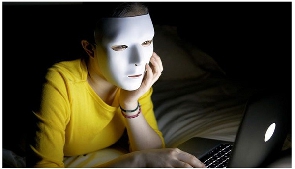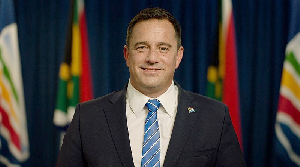Opinions of Saturday, 9 September 2023
Columnist: Dunstan Guba
Not everyone on social media is real
It’s important to be aware that not everyone on social media is who they claim to be and to exercise caution when interacting with strangers online. It’s always a good idea to verify the identity of someone before sharing personal information or engaging in any kind of transaction with them. Additionally, it’s important to be vigilant and skeptical of any information that seems too good to be true or that comes from sources that cannot be verified.
Fake accounts on social media can be created for various reasons. Some people create fake accounts to protect their anonymity while expressing opinions or engaging in activities that they don’t want to be associated with their real identities. Others create fake accounts as part of a deliberate effort to deceive or manipulate others, such as spreading false information, influencing political opinions, or scamming people out of money.
One type of fake account is a bot account, which is created and controlled by computer programs rather than humans. These bots can be programmed to perform various tasks, such as liking or retweeting specific posts, following certain accounts, or generating automated responses to messages. Bot accounts can be used to amplify messages, manipulate public opinion, or even spread malware.
Another type of fake account is a catfishing account, where someone uses a fake identity to deceive others into forming a relationship or friendship with them. This can be done for a variety of reasons, such as seeking attention, emotional connection, or financial gain.
To protect yourself from fake accounts on social media, it’s important to be cautious and skeptical of any account that seems suspicious. Look for signs such as a lack of personal information, a generic profile picture, or a suspiciously large number of followers or likes. Additionally, be wary of accounts that ask for personal information or money, or that try to steer you towards clicking on links or downloading files.
Always verify the identity of someone before sharing any personal information or engaging in any kind of transaction with them. Fake accounts can be created in various ways, and the methods used can vary depending on the goals of the creator. Here are a few practical illustrations of how fake accounts can be created:
Manual account creation One way to create a fake account is to do it manually. This involves creating a new email address and using it to sign up for a social media platform using a pseudonym. The creator can then add a profile picture and fill out the profile information with fake details. This method is time-consuming, but it allows the creator to have full control over the account and its activities.
Account cloning: Another method used to create fake accounts is cloning. This involves copying the details of an existing account and using them to create a new account. The creator can then make some minor changes to the profile information and picture to make it look slightly different from the original account. This method is faster than manual account creation, but the creator has less control over the activities of the account.
Bot account creation: Bot accounts are created using automated software that can create multiple accounts at once. The software can be programmed to generate random usernames, email addresses, and profile pictures to make the accounts look more realistic. This method is fast and efficient, but the accounts created may not be as sophisticated as those created manually.
What are bots?
Bots, short for robots, tirelessly comment on Facebook posts, share content, or artificially stoke online debate on marginal or otherwise overlooked topics. Their behavior, as the name suggested, resembles that of automated robots.
It is essential, however, to differentiate between good and bad bots. Good bots may automatically share news, or weather forecasts, as well as earthquake alerts or satellite images on social media.
Bad bots, in contrast, are designed to imitate genuine human activity to advance a certain agenda. Depending on the algorithm, such computer programs may compose and publish social media posts or comments, follow others, or even send out friendship requests.
Bad bots can distort reality by amplifying certain political opinions on social media platforms and drawing artificial attention to certain issues by repeatedly sharing falsehoods or disinformation and undermining constructive online debate.
Recently, researchers from Carnegie Mellon University analyzed over 200 million Tweets sent out in 2020 discussing coronavirus or COVID-19. They came to a worrying conclusion: 82% of the top 50 influential retweeters were bots; likewise 62% of the top 1,000 retweeters.
How can I spot bots?
Bots, like fake social media accounts, can be detected if you pay attention to:
Account names
Usernames consisting of jumbled combinations of letters and words could indicate you are dealing with a bot.
Profile pictures
Does the account lack a profile picture? Does it show someone, but in very poor quality? If so, be wary.
Profile bio/account details
Sparse profile information, a recent registration date, and a dubious location that does not seem to match the person in question should get your alarm bells ringing.
Online behavior that seems out of character for a human
Have you observed a single social media account simultaneously publishing identical content across different platforms, or underneath several different posts? Does the account post countless crude replies in a very short time, or constantly retweet content? If the answer is yes, you are most likely dealing with a bot.
Bots are also known to typically follow a large number of other accounts while having few to no followers of their own.
Account purchase: Some people may choose to purchase fake accounts instead of creating them. There are online marketplaces where people can buy social media accounts that have already been created. These accounts can be purchased in bulk and can be used for various purposes, such as spreading misinformation or influencing public opinion.
It’s important to note that creating fake accounts is against the terms of service of most social media platforms, and it can lead to suspension or permanent banning of the account. It’s always best to use social media platforms honestly and ethically.
Detecting fake accounts on social media can be challenging, as they can be designed to look very similar to real accounts. However, some signs can help you identify fake accounts:
Lack of personal information: Fake accounts often have limited personal information, such as a generic profile picture, little or no information in the “About” section, and few posts or interactions with other users.
Suspicious profile picture: The profile picture of a fake account may be a stock image or a low-quality image that appears to be taken from the internet. It may also be a picture of a celebrity or someone who looks too good to be true.
Unusual activity: Fake accounts may engage in unusual activity, such as following a large number of accounts in a short period or liking and commenting on posts that are unrelated to the account’s interests.
Unusual engagement patterns: Fake accounts may have a high number of followers but a low engagement rate, such as few likes and comments on their posts. This could be a sign that the followers are fake or that the account is not engaging with real people.
Suspicious links: Fake accounts may post links to suspicious websites or ask for personal information, such as passwords or credit card details.
Use of automated language: Some fake accounts use automated language to respond to messages or comments. This can be detected by the repetitive and generic nature of the responses.
It’s important to note that none of these signs are definitive proof of a fake account, and some legitimate accounts may exhibit some of these signs. However, if you notice several of these signs together, it’s a good indication that the account may be fake.
If you come across a fake account on social media, it’s important to report it to the platform’s administrators so they can take appropriate action. Here are some steps you can take to report a fake account on common social media platforms:
Facebook: To report a fake Facebook account, go to the account’s profile page, click on the three dots in the top right corner, and select “Report.” From there, you can choose the reason for your report, such as “Pretending to be someone else” or “Fake account.” You can also provide additional information to support your report.
Twitter: To report a fake Twitter account, go to the account’s profile page, click on the three dots in the top right corner, and select “Report.” From there, you can choose the reason for your report, such as “Impersonation” or “Spam.” You can also provide additional information to support your report.
Instagram: To report a fake Instagram account, go to the account’s profile page, click on the three dots in the top right corner, and select “Report.” From there, you can choose the reason for your report, such as “Impersonation” or “Fake account.” You can also provide additional information to support your report.
LinkedIn: To report a fake LinkedIn account, go to the account’s profile page, click on the three dots in the top right corner, and select “Report this profile.” From there, you can choose the reason for your report, such as “Fake profile” or “Inappropriate content.” You can also provide additional information to support your report.
In addition to reporting the fake account to the platform, you can also report it to relevant authorities if the account is engaging in illegal activities, such as fraud or harassment. It’s important to be vigilant and report fake accounts to protect yourself and others from potential harm. It is also important to report to the Ghana Police Service Cybercrime Unit through the Criminal Investigations Department in the event you are being impersonated or become a victim of an Impersonation Scam.













